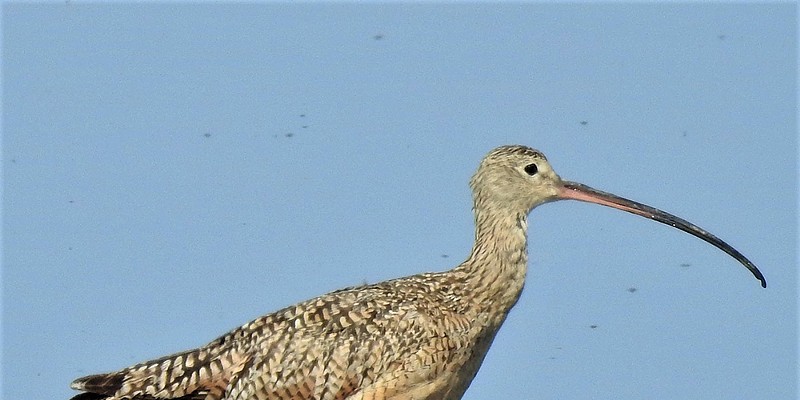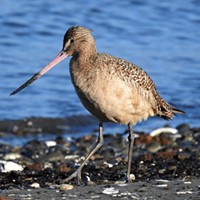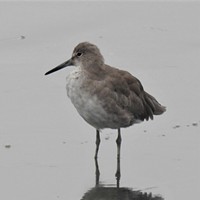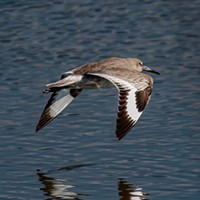Here in Humboldt we're pretty famous for our shorebirds. Among birders, anyway.
A whole lot of shorebirds, in fact: Humboldt Bay is estimated to host to around 850,000 of them annually. There's even an international birding festival here, Godwit Days, named for one of our most celebrated sandpipers. With much of the county located on the Pacific flyway, a major migration route, we're treated to more than 30 species of shorebirds in all shapes, sizes and colors — though, not surprisingly, gray-brown is the predominant hue.
If you've been wondering who's who among the birds dotting the bay or drubbing along the river mouths, below are 10 of the most common shorebirds you'll encounter, from tall to small, with a few highly unscientific tips (and a complete slideshow at northcoastjournal.com) to help you identify them.
Long-billed curlew. The name says it all — that bill is a whopper. I sometimes wonder what keeps this bird from tipping over. The bill is decurved (bird talk for "curves down") which helps distinguish the curlew from the marbled godwits with which it sometimes flocks. Our largest sandpiper at 23 inches in length, the long-billed curlew is as big as a small heron. Its plumage is mottled with dark and light brown; when it flies, the rich cinnamon underwing is visible, a good field mark. It uses that long bill to probe the mud for edibles, though it will also glean insects in pastures. So, if you're at the Arcata Marsh scanning through a flock of large buffy-brown shorebirds and one seems to stand taller than the rest, take a good look at the bill.
Marbled godwit. These are the quintessential shorebirds of Humboldt Bay, avian celebrities if you will. Their likeness turns up on banners, T-shirts and other media materials promoting Humboldt. And it's no wonder — godwits are particularly photogenic, with unique two-toned bills that are pink at the base, dark at the tip and upcurved, which, in my opinion, gives these birds a rather cheerful look. Their plumage is rich buff marbled with dark brown, and in flight they show cinnamon underwings like long-billed curlews. You can find them in large numbers feeding on mudflats and occasionally in pastures.
Willet. Willets are pretty unremarkable birds, drab, mousy gray in their winter plumage with a longish, thick bill. It's only when they take off that their dramatic black-and-white wing pattern is evident. When an entire flock goes by it's a spectacular sight. Willets are abundant winter residents in Humboldt and can be found feeding along the edges of the bay, often with godwits.
Greater yellowlegs. Here's another aptly named shorebird because the legs of this gangly sandpiper are deep yellow. You may have heard the distinctive three-note call of a greater yellowlegs without knowing. Aside from those eponymous legs, the greater yellowlegs is tall and fairly slender, with gray-brown plumage mottled with white and a long bill that curves up slightly. They're common in both fresh and saltwater marshes. If there's a greater yellowlegs, there has to be a lesser yellowlegs, right? Well, there is, but it's relatively uncommon here in Humboldt.
Whimbrel. The cheeky whimbrel is one of my favorite birds. This small curlew has a big personality with a raucous voice to match. A whimbrel is like a long-billed curlew that shrank a few inches in the wash, with somewhat darker plumage and distinctive black stripes on its head. The decurved bill is shorter, too, making the curve seem more pronounced. You often can find whimbrels roosting on old railroad pilings out in the bay.
Short-/long-billed dowitchers. Dowitchers are medium-sized shorebirds with long, relatively straight bills that droop slightly at the tip. They're compact, short-necked drubbers that probe the mud like feathered derricks, usually in flocks. Their characteristic humpbacked posture makes them easy to spot. Distinguishing long-billed from short-billed, however, is another matter. Oddly enough, it has nothing to do with the length of the bill, which is an unreliable field mark. To complicate matters, dowitchers come in a bunch of different plumages: spring, winter, adult, juvenile and various stages in between. The best way to tell long-billed from short-billed is to bring a shorebird expert with you — better yet, bring two and see if they agree.
Dunlin. Dunlins in breeding plumage are bold and showy, with a rufous red back and black belly. By the time they arrive in Humboldt to overwinter, though, most of those colors are gone, leaving a bird that's, well, dun — drab grayish brown with plain white undersides. Dunlins are chunky, big-headed sandpipers with long dark bills that droop. Size-wise, they're a little smaller than a robin and they can be found anywhere there are mudflats. They often migrate in huge flocks that fill the sky, reminiscent of a certain Hitchcock film.
Western sandpiper and least sandpiper. These are the smallest shorebirds on our list and belong to the so-called "peep" group, which are brown, sparrow-sized sandpipers that are notoriously tough to differentiate. Both western and least sandpipers are abundant here during fall and winter, and they often flock together. But the western is a bit larger than the least and has a longer, stouter bill that droops down. Its posture tends to be more forward-leaning as well, giving it an elongated look. When a flock of westerns is feeding, they're all business, dredging the mud like little machines.
Least sandpipers are dainty little birds, shorter and rounder in appearance than westerns and with a thinner, shorter droopy bill. Their behavior is a bit more frenetic — they tend to dash around the mudflats like the sky is falling. But their best field mark is their bright yellow leg color. In poor light (pretty much every day here in Humboldt), the yellow can be hard to pick out; also, those wee gams might be covered in mud.
The optimum time to find loads of shorebirds varies with the tide. Often an incoming tide will push birds closer to shore for better viewing. So, grab a tide chart and a friend, borrow a spotting scope — even a good pair of binoculars will do — and test your shorebird know-how.
Sarah Hobart (she/her) is a freelance writer based in Humboldt County.







Comments
Showing 1-1 of 1